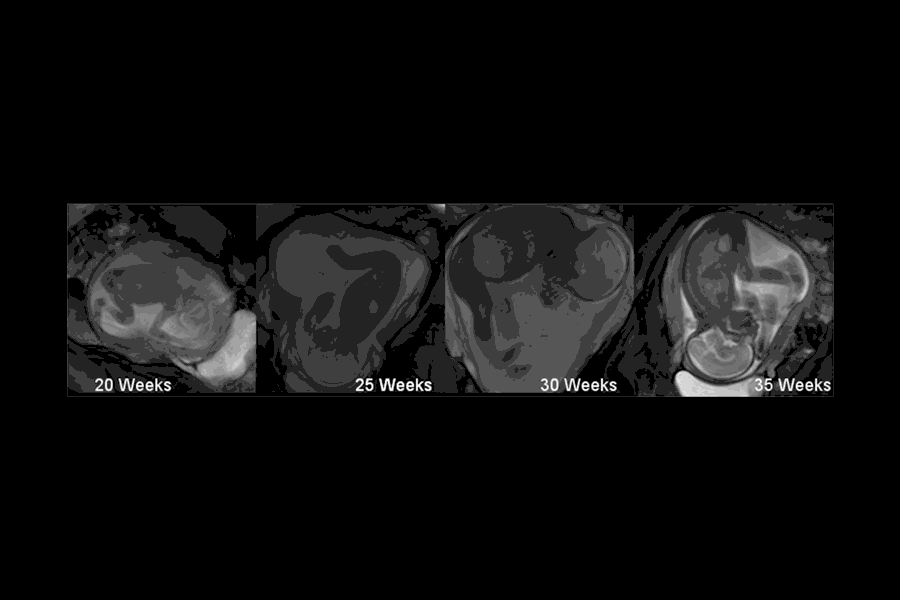Baby in the Womb in the Clouds Is That a Spiritual Sign?
Why Do Babies Kick in the Womb?

The first time a pregnant woman feels her baby kick can be surprising — a sudden reminder that the tiny creature growing inside her has a mind of its own. But why do babies kick?
Though the womb is a tight space in which to exercise, it turns out that those kicks are vital for the infant's healthy bone and joint evolution, an expert told Alive Science.
Fetuses begin moving in the womb nigh as early as 7 weeks, when they slowly bend their necks, according to a review paper published in the journal Ultrasound in Obstetrics & Gynecology. As the babies abound, they gradually add together more movements to their repertoire, such as hiccupping, arm and leg movements, stretching, yawning, and pollex sucking. But the mom won't feel the bigger movements — such as kicks and punches — until 16 to 18 weeks into her pregnancy, when the baby is a fleck stronger. [In Photos: How Babies Larn]
Babies demand their do, likewise
An entire field of research is defended to figuring out whether the baby is in control of its move or if those movements are but a reflex, said Niamh Nowlan, a bioengineer at Imperial College London. "Early movements are likely to be purely reflex," Nowlan told Live Scientific discipline in an electronic mail, but as the movements get more coordinated, "information technology'south likely the brain is in control of how much and when the baby moves." (Reflexes, on the other hand, come from the spinal cord and don't require input from the brain.)
Scientists may not know for sure if the movements are voluntary or involuntary, only Nowlan said the research is clear that motility is important. "The baby needs to move [in the womb] to exist good for you after birth, particularly for their basic and joints," she said. In a review she published in the journal European Cells and Materials, Nowlan described how a lack of fetal movement can lead to a multifariousness of congenital disorders, such as shortened joints and thin bones that are susceptible to fracture.
For meaning women wondering if their baby is likewise kicky, or not kicky plenty, Nowlan said there's no established corporeality of normal fetal move during pregnancy. "Pregnant women are told to look out for significant changes in movements, which is quite vague advice, simply it's the best that can be given at the moment," she said.
That's because it'due south hard for scientists to study fetal movements, because the only way to measure them is in the hospital and it can be done for only a brusque period at a fourth dimension. To get around this problem, Nowlan and her colleagues are working on developing a fetal-movement monitor that the mother tin can article of clothing during her normal daily activities. The researchers tested the monitor on 44 women who were 24 to 34 weeks pregnant and could accurately observe breathing, startle movements and other general torso movements. Their results were published in the periodical PLOS One in May.
I study, published in 2001 in the journal Human Fetal and Neonatal Move Patterns, found that boys may movement around more in the womb than girls. The average number of leg movements was much higher in the boys compared to the girls at 20, 34 and 37 weeks, that study found. But the study's sample size was small, just 37 babies, so Nowlan and her colleagues are hesitant to claim there's a relationship between gender and fetal movement.
Fetal kicks can pack a punch
It's unlikely that each woman will feel the same thing when her baby starts kicking.
"Different women feel the sensation quite differently, and sensations tin can vary between pregnancies," Nowlan said. In her own two pregnancies, for example, she said she was much more sensitive to the movements of her second child compared to those of her first. "I could always tell where my son's feet were, whereas that wasn't really the example for my kickoff," she said. She hypothesized that this variation could have arisen considering the womb muscles are more stretched out subsequently the first pregnancy, a topic she'southward now studying.
The most-pronounced movements mothers will experience are the baby's kicks. A recent written report from Nowlan and her colleagues, published in the Periodical of the Royal Society Interface in January, found that the impact of the baby'southward kick increases from 6 lbs. (2 kilograms) of force at 20 weeks to 10 lbs. (4 kg) of force at xxx weeks. After that point, the baby's kicking force decreases to just nether four lbs. (2 kg). The scientists said they suspect the decrease in movement occurs considering there is less room for the infant to move effectually.
But babies in the womb are doing more than than just boot. By 15 weeks, the baby is also punching, opening and closing its mouth, moving its head, and sucking its pollex. A few weeks after, the babe will open and close its eyes. But the mother will experience only the major movements: kicking, punching and perchance large hiccups.
The babies also do "breathing movements,'" said Nowlan. While the baby isn't actually breathing air, it will perform the same move, just with amniotic fluid. Nowlan explained that babies who don't perform this movement often have problem breathing once they're born, because they oasis't congenital upward their chest muscles.
Feeling a baby moving and kicking in the womb might be a weird sensation, but information technology's simply a sign of salubrious development.
Original article on Live Science.
Source: https://www.livescience.com/62928-why-babies-kick.html

0 Response to "Baby in the Womb in the Clouds Is That a Spiritual Sign?"
Post a Comment